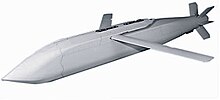
Back إيه جي إم-154 Arabic AGM-154 Joint Standoff Weapon Czech AGM-154 Joint Standoff Weapon German AGM-154 JSOW Spanish AGM-154 JSOW Finnish AGM-154 Joint Standoff Weapon French AGM-154 Joint Standoff Weapon Croatian AGM–154 JSOW Hungarian AGM-154 Joint Standoff Weapon ID AGM-154 Joint Standoff Weapon Italian
This article needs additional citations for verification. (December 2020) |
| AGM-154 Joint Standoff Weapon | |
|---|---|
 | |
| Type | Glide bomb |
| Service history | |
| In service | December 1998 – present |
| Used by | United States Armed Forces Republic of China Air Force Royal Canadian Air Force Finnish Air Force Polish Air Force Hellenic Air Force Royal Australian Air Force Royal Moroccan Air Force Turkish Air Force Republic of Singapore Air Force[1] |
| Wars | Operation Desert Fox Operation Southern Watch NATO bombing of Yugoslavia War in Afghanistan (2001–2021) Iraq War |
| Production history | |
| Manufacturer | Raytheon |
| Unit cost | AUPP AGM-154A: $282,000 AGM-154B: $484,167 AGM-154C: $719,012 |
| Specifications | |
| Mass | 483 to 497 kg (1,065 to 1,095 lb) |
| Length | 410 cm (160 in) |
| Diameter | 330 mm (13 in) |
| Wingspan | 270 cm (106 in) |
| Warhead | BLU-97/B - Combined Effects Bomblets (JSOW A) BLU-108 - Sensor fused weapon (JSOW B - now cancelled) BROACH multi-stage warhead (JSOW C) |
Operational range | low altitude release: 22 kilometres (12 nmi) high altitude release: 130 kilometres (70 nmi) |
Guidance system | Inertial Navigation System coupled with Global Positioning System, terminal Infrared homing (AGM-154C Only) |
The AGM-154 Joint Standoff Weapon (JSOW) is a glide bomb that resulted from a joint venture between the United States Navy and Air Force to deploy a standardized medium-range precision-guided weapon, especially for engagement of defended targets from outside the range of standard anti-aircraft defenses, thereby increasing aircraft survivability and minimizing friendly losses. It is intended to be used against soft targets such as parked aircraft, trucks, armored personnel carriers (APCs), and surface-to-air missile sites (SAMs). Prior to launch, it is given a destination through either a predesignated waypoint or a point marked through a targeting pod. It glides, using two wings that pop out for added lift, to the marked destination and dispenses submunitions in a short, roughly linear pattern.[2] The designation of the Joint Standoff Weapon as an "air-to-ground missile" is a misnomer, as it is an unpowered bomb with guidance avionics, similar to the older GBU-15.
- ^ AGM-154 Joint Standoff Weapon (JSOW), Airforce Technology, December 2016
- ^ "AGM-154 Joint Standoff Weapon (JSOW)". United States Navy. Retrieved 2023-12-19.